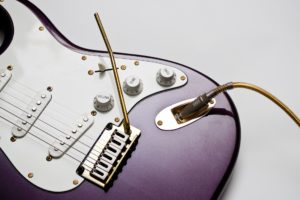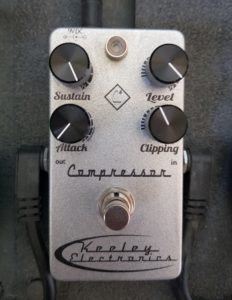The Stratocaster is one of the most famous guitars of all time and it’s used by loads of pro guitarists. But is it good for rock music?
In this article, I’ll address the pros and cons of using a Stratocaster for rock, and give you some tips to get the best tone possible. So let’s get started!
The Quick Answer
Stratocasters are great guitars for rock music. They have a crisp and sharp tone, versatile controls, plus they are lightweight and comfortable. However, they are suseptible to feedback, and have a fairly thin tone.
So to get the best rock sound out of your Strat, you can use a compression pedal to thicken out the tone, and a noise gate pedal to reduce the feedback. Using the neck/ middle pickup, and reducing the treble and increasing the bass on your amp will also help.
Pros of Using a Strat for Rock
The Strat is a pretty versatile guitar and there are plenty of reasons why a Stratocaster is great for rock. Here are 5 of the main advantages of the Strat for rock music.
- Clear and crisp tone
- 5 way pickup selector
- Two tone controls
- Lightweight and comfortable design
- Floating bridge feature
1. Clear and Crisp Tone
The Strat has three single coil pickups which are prized for producing very clear notes. Single coil pickups favour high-range frequencies, which means they place more emphasis on the treble, rather than the bass.
The result of this, is a very bright and crisp tone. It’s great for note separation and perfect for cutting through the mix when you are soloing.
2. pickup selector
The majority of electric guitars have two pickups, whereas the Strat has three. One is located in the bridge position, another in the neck, and then there’s one in between the two.
The placement of these pickups dramatically impacts the tone. For example, bridge pickups sound brighter and sharper than neck pickups, which sound warmer and more mellow.
So when you want to play lead guitar, you can use the bridge pickup to help you cut through, and when you want to play rhythm, the neck pickup will sound great. Then you also have the middle pickup, to give you a more balanced tone.
Check out this article I’ve written on the difference between neck and bridge pickups to learn more about this topic.
What really sets the Strat apart though, is the 5 way pickup selector. It allows you to activate the following pickup combinations:
- Position 1: bridge pickup only
- Position 2: bridge and middle pickups together
- Position 3: middle pickup only
- Position 4: middle and neck pickups together
- Position 5: neck pickup only
This gives you so much versatility to dial in the perfect tone for any situation, and it’s one of the reasons the Strat is so unique and popular.
3. Two Tone Controls
To give you even more flexibility, the Strat also has two tone controls, compared to just one that you’ll find on a lot of other electric guitars. This allows you to adjust how bright the middle and neck pickup sound. The result, is even more flexibility to dial in the exact rock tone you’re after.
4. Lightweight and Comfortable Design
Another really great advantage of the Strat for any type of music, is how comfortable it is. It’s a pretty lightweight guitar weighing in at just 8 pounds (3.6 kg), and it has a contoured and thin body.
This means it’s super easy to sit and stand with for long periods of time. You won’t feel held back by the Strat at all when it comes to playing gigs and moving around the stage.
It also has a pretty slim neck profile. This means it’s easy to move around the fret board at speed, and practise your shredding.
5. Floating Bridge feature
It’s also difficult to talk about a Strat without mentioning the floating bridge. There are two main bridge types, fixed and floating.
Fixed bridges are more simplistic, but floating bridges have a tremolo arm. This allows you to change the pitch of the strings by pushing up or down on it. It’s a really great feature that you won’t find on guitars like the Telecaster or Les Paul.
Check out this post on the difference between fixed and floating bridges to find out more.

Cons of Using a Strat for Rock
Okay, so now we’ve been through some reasons why a Strat is good for rock, let’s go through some of the drawbacks.
Unfortunately, there are a couple of things that hold a Strat back from being the absolute perfect guitar for rock music.
- Feedback and humming
- Thinner tone
Let’s go through each reason individually.
Feedback and humming issues
Whilst the single coil pickups are great for producing bright tones, they unfortunately suffer from quite a bit of feedback and humming background noise.
This is particularly evident when you increase the gain or distortion on your amp, something you need to do quite a bit for rock.
Thin tone
The Strat sounds bright and crisp, which is great. But it also sounds quite thin. This is due to a couple of reasons.
The single coil pickups favour treble frequencies, rather than bass. The result is a pretty weak bass output. This causes the tone to have a lack of depth.
This can be an issue with rock music, as you generally need quite a thick and beefy tone.
The maple and alder tone woods don’t help either. They tend to limit the resonance, again contributing to this thin and brittle tone which doesn’t have much sustain or power.
Tips On Using a Strat for Rock
Okay, with that in mind, what can we do to turn a Strat into a rock machine? There are actually quite a number of things you can do to solve the feedback issue, and make the Strat sound thicker, giving it that great rock tone.
how to get a good rock tone with a strat
- Use the middle or neck pickup
- Increase the bass and mids and reduce the treble
- Invest in a good compression pedal
- Use a noise gate pedal to reduce the feedback
- Consider using a distortion or overdrive pedal
Let’s go through each tip in a bit more detail.
1. Use the Neck or Middle Pickup
So one of the issues with using a Strat for rock, is that the tone is quite thin and brittle. This is because it focuses more on the treble, rather than the bass.
One super quick thing you can do to address this, is use the neck or middle pickup, rather than the bridge pickup.
This is because the bridge pickup sounds brighter and favours treble frequencies. Whereas the neck pickup sounds warmer because it favours bass frequencies.
Using the neck or middle pickup helps to switch the Strats tone from being too sharp and harsh, to sounding fuller, warmer, more suited to rock music.
Take a look at this in-depth guide to a Stratocaster’s controls to learn more about getting the most from your guitar.
2. Increase the Bass and Mids and Reduce the Treble
Again, to counter act the brightness of your Strat’s natural tone, and make it sound warmer and fuller, you can tweak the settings on your amp.
If your amp has separate bass, mids and treble controls, then you’ll want to turn the treble down a bit, and increase the bass and mids. The result, will be a fatter rock style sound.
If your amp doesn’t have these settings, it may have a control called “tone” or “EQ”. Turning it counter-clockwise will have the same affect as described above.
Other amps also have controls like presence and contour.
Presence works basically the same as treble, so turn this control down a bit.
Contour works the opposite way around to the mids control. So to thicken up your tone, you’ll need to turn the contour control down a bit.
Check out this step-by-step guide to amp settings to learn more about creating the ultimate rock tone with a Stratocaster.
3. Invest in a Compression Pedal
One of the most effective ways to make your Strat sound perfect for rock music, is to use a compressor pedal.
Compression pedals have two main effects:
- They make your tone sound smoother by minimising the effects of inconsistent picking
- They increase the sustain of your tone, making it sound thicker and fuller
I always recommend the Keeley Compressor as one of my favourites. It’s very easy to use, but also gives you plenty of control. It’s basically the easiest way to give your Strat a fatter rock style sound.
It’s also got a really sleek looking design that looks great on my pedal board. You can check out the Keeley Compressor on Guitar Center.

If you don’t want to spend as much as you have to for the Keeley Compressor, then I think the Boss CS-3 is a really good option.
One of my favourite things about Boss pedals is how robust they are, so they’re really great for gigging. Or just if you’re just clumsy like me and manage to drop it when you first open it out of the package!
You can also find the Boss CS-3 compression pedal on Guitar Center with free shipping.
4. Use a Noise Gate Pedal
Now let’s talk about the feedback and humming issue you get with Strats, when you crank up the gain on your amp. If you want to get rid of this, then check out noise gate pedals. They essential remove any unwanted noise and buzzing from your signal, before it goes into your amplifier. This way you won’t be held back by annoying humming.
5. Consider an Overdrive or Distortion Pedal
Finally, a great way to get the ultimate rock tone on a Strat, is by investing in an overdrive or distortion pedal.
They are both gain-related pedals, however they sound very different. Overdrive pedals sound gritty and crunchy, whereas distortion pedals give you that wall-of-sound sustain which is much more aggressive.
You’ll see one, or both of these pedal types on pretty much every rock guitarists pedal board. Take a look at this guide to the essential effects pedals for rock music to learn some more.
If you’re really lost and don’t have a clue what effects pedals do, then check out this article I’ve written to give you an introduction to guitar effects pedals.
Modifying a Strat for Rock
If you’re really serious about making your Strat the ultimate rock machine, then you can consider modifying it. This is a very effective solution, but it will take some more time, effort and money. Here are a few modifications to consider:
- Using thicker strings to give you better sustain and more power behind your tone.
- Swapping out the bridge single coil pickup for a humbucker to deal with some of the feedback issues and give you a fuller sound.
- Add a tone control for your bridge pickup to give you more versatility and control.
Who Uses a Stratocaster for Rock?
There are plenty of pro guitarists out there that use, or have used Strats for rock music. Here’s a quick list.
- Jimi Hendrix
- Jeff Beck
- Stevie Ray Vaughan
- Rory Gallagher
- Eddie Van Halen
- Eric Clapton
- David Gilmour of Pink Floyd
- Ritchie Blackmore of Rainbow
- Mark Knopfler of Dire Straits
So there you go! That’s how to use a Strat for rock! I hope you’ve found this article helpful, thanks for reading. Here are some other posts you might find useful:
